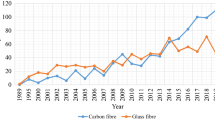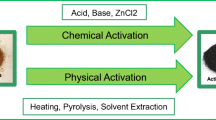Abstract
The adsorption of lead in aqueous solution by discarded tire rubber (TR) and by carbonaceous adsorbents (CAs) prepared from it by thermal and chemical treatments is studied. TR was heated at 400 or 900 °C for 2 h in N2 atmosphere or treated chemically with H2SO4, HNO3, H2SO4/HNO3, HCl, NaOH, HCl-NaOH or NaOH-HCl for 24 h. TR and CAs were characterized physico-chemically with regard to their texture, elemental composition and surface chemistry. The adsorption of lead was studied, mainly from the kinetic standpoint, using 4×10−3 mol L−1 Pb2+ solutions at initial pH 2.0, 5.7 and 12.6. TR is practically a non-porous material. The heat treatment of TR mainly develops meso- and macroporosity. The effect on macroporosity is stronger when HNO3 and H2SO4/HNO3 are used. For all adsorbents, the adsorption of lead is not measurable when adsorptive solution at pH 2 is used. With an increase of pH from 5.7 to 12.6, the kinetics of adsorption becomes faster and the amount of lead adsorbed significantly increases. For the solution at pH 12.6 and an adsorption time of 8 h, the adsorption percentage is 36 wt% for TR. For the CAs prepared by heat treatment of TR, it is higher than 50 wt%. For longer adsorption times, the kinetics is much slower for the product of TR treatment with HNO3. However, the corresponding adsorption percentage is as high as 93 wt% for an adsorption time of 264 h. TR and the CAs, in particular the product heated at 400 °C, are good adsorbents to be used in the rapid removal of a significant amount of lead from aqueous solution.
Similar content being viewed by others
References
Baes, C.F., Mesmer, R.E.: The Hydrolysis of Cations. Wiley, New York (1976)
Castells, X.E.: Reciclaje de Residuos Industriales. Díaz de Santos, Madrid (2000)
Cookson, J.C.: Adsorption mechanisms: the chemistry of organic adsorption on activated carbon. In: Cheremisinoff, P.N., Ellerbusch, F. (eds.) Carbon Adsorption Handbook, pp. 241–279. Ann Arbor, Ann Arbor (1978)
De Marco Rodriguez, I., Laresgoiti, M.F., Cabrero, M.A., Torres, A., Chomón, M.J., Caballero, B.: Pyrolysis of scrap tyres. Fuel Process. Technol. 72, 9–22 (2001)
Greenwood, N.N., Earnshaw, A.: Chemistry of the Elements. Pergamon Press, Oxford (1984)
Ho, Y.S., McKay, G.: Pseudo-second order model for sorption processes. Process. Biochem. 34, 451–465 (1999)
Jain, A.K., Gupta, V.K., Suhas, A.B.: Utilization of industrial waste products as adsorbents for the removal of dyes. J. Hazard. Mater. B 101, 31–42 (2003)
Lagergren, S., Svenka, K.: About the theory of so-called adsorption of soluble substances. Vetenskapsakad Handl. 24(2), 1–39 (1898)
Manchón-Vizuete, E., Macías-García, A., Nadal Gisbert, A., Fernández-González, C., Gómez-Serrano, V.: Preparation of mesoporous and macroporous materials from rubber of tyre waste. Micropor. Mesopor. Mater. 67, 35–41 (2004)
Manchón-Vizuete, E., Macías-García, A., Nadal Gisbert, A., Fernández-González, C., Gómez-Serrano, V.: Adsorption of mercury by carbonaceous adsorbents prepared from rubber of tyre waste. J. Hazard . Mater. B 119, 231–238 (2005)
Mohan, D., Singh, K.P.: Single-and multi-component adsorption of cadmium and zinc using activate carbon derived from bagasse—an agricultural waste. Water Res. 36(9), 2304–2318 (2002)
Netzer, A., Wilkinson, P., Beszedits, S.: Removal of trace metals from wastewater by treatment with lime and discarded automotive tires. Water Res. 8(10), 813–817 (1974)
O’Neill, P.: Environmental Chemistry. Chapman & Hall, London (1993)
Pretsch, E., Clerc, T., Seibl, J., Simon, W.: Tablas para la Elucidación Estructural de Compuestos Orgánicos por Métodos Espectroscópicos. Alambra, Madrid (1980)
Rowley, A.G., Husband, F.M., Cunningham, A.B.: Mechanisms of metal adsorption from aqueous solutions by waste tire rubber. Water Res. 18(8), 981–984 (1984)
San Miguel, G., Fowler, G.D., Sollars, C.J.: A study of the characteristics of activated carbons produced by steam and carbon dioxide activation of waste tyre rubber. Carbon 41(5), 1009–1016 (2003)
Yan, D., Yan, J., Chi, Y., Pei, Y., Cen, K.: Characteristics of heavy metals adsorption by carbon blacks from pyrolysis of used tires in pilot-scale rotary kiln. Ranliao Huaxue Xuebao 34(3), 353–358 (2006)
Zhang, Z., Chi, Y., Yan, D., Yan, J., Cen, K.: Characteristic and application of pyrolytic char derived from pilot scale pyrolysis of scrap tires. Ranliao Huaxue Xuebao 32(3), 312–317 (2004)
Author information
Authors and Affiliations
Corresponding author
Rights and permissions
About this article
Cite this article
Alexandre-Franco, M., Fernández-González, C., Macías-García, A. et al. Uptake of lead by carbonaceous adsorbents developed from tire rubber. Adsorption 14, 591–600 (2008). https://doi.org/10.1007/s10450-008-9115-z
Received:
Revised:
Accepted:
Published:
Issue Date:
DOI: https://doi.org/10.1007/s10450-008-9115-z




